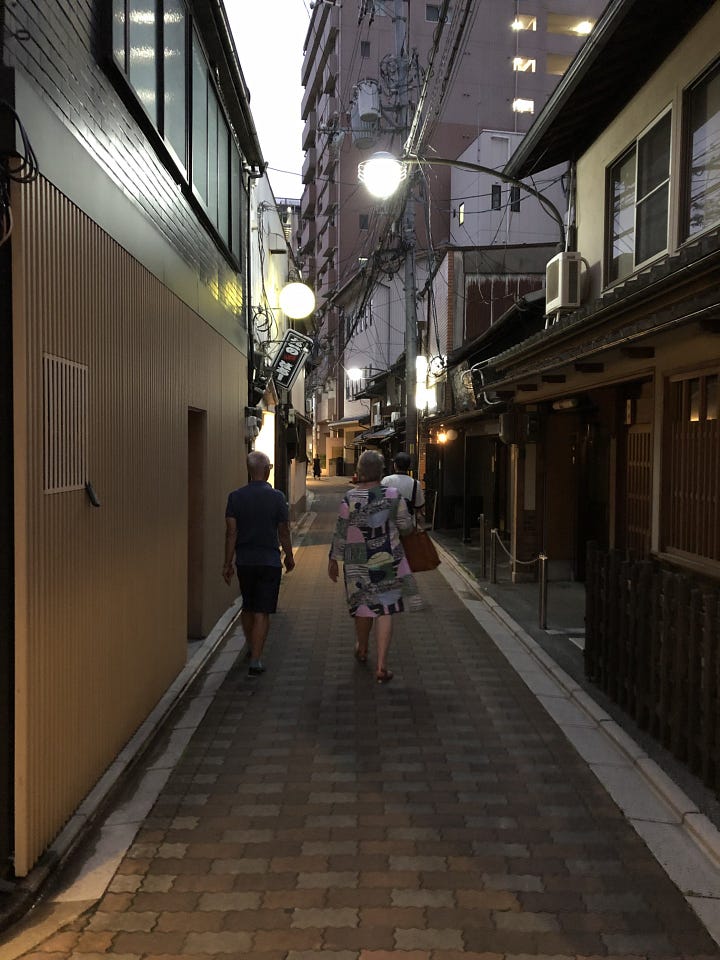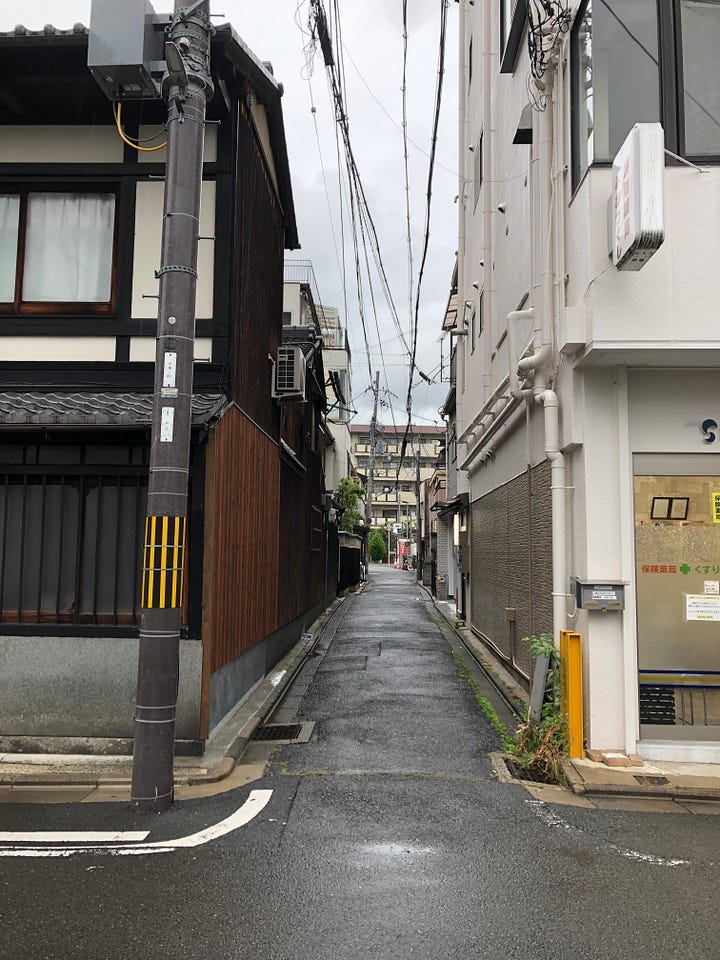



Kyoto reminds me of Rome. It’s scent, posture and complexion is similar but without being Rome’s rather than Kyoto’s. They’re both monochromic ancient capitals but there’s a difference between them, maybe as great as the near ten thousand kilometres Google tells me I’d have to travel to get from one to the other. Rome wears her sepia tones that have a faded nimbus glow, like the face of Da Vinci’s Vitruvian Man, but Kyoto’s skin isn’t paper brushed with paint by candlelight and which aged in Mediterranean air. Like Rome, Kyoto does have a gallery of side streets branching off its main roads which you can venture down, like blood vessels, into the city’s guts, hearts and dark intestines, but pass one building after another down those streets and you will pass compact, two-storey houses, offices and hotels painted in dark greys and blacks and also browns and whites. You’ll start to wonder why Christopher Nolan or Michael Mann have never shot a film here. Kyoto’s dressed in the fashion of the cars, TV sets, and computers Japan built its new civilisation from after the old one, once centred around Kyoto, burned in the A-bomb’s fires.
Or did it? Down those Kyoto side-streets, you can walk past a sleek Modernist house, no ornamentation and all glass windows and steel doors, and come to one that looks like it could have been standing when samurai walked down these streets: an assemblage of wooden frames under a black tiled roof. You can imagine the rooms inside that you’ve only seen in pictures and movies and where the room is four paper screens in wooden window frames and a straw tatami matt cushions your steps. The houses are compact in Kyoto. This house is slotted tightly beneath the Modernist house you just walked by and another like it right next door on the other side. Turn the corner and you’ll see a Shinto shrine at the end of the street but before you get to it you pass two neon signs and electricity lines hang over your head from the wooden posts lining the streets and marking the way to the shrine. Past and present live packed together like books on a shelf.
You step inside the shrine and take out your phone to take a picture but then you see the sign. “No commercial photography.” The shrine’s a business. The monks charge fees for photographers to take pictures and you assume for other stuff and this keeps the shrine running. You don’t want to risk being mistaken for a commercial photographer taking photos without permission and get into an argument with the monks. Your Japanese isn’t good enough to explain and you don’t want to argue with the monks. You respect them. They’re running an ancient religion like a modern business.
The next shrine you visit, well it’s actually a temple, is a Buddhist one. Outside, a poster advertises their new android monk for giving services and it shows you a picture of the android monk. It looks like a monk and it’s talking like a monk yet thick wires and pistons jut out of the back of its head and down into its back. It’s the old world plugged in.
There’s a festival on while you’re in Kyoto and they need a god to lead a parade for the festival. The god also has to be a boy from Kyoto. You’re told this year it’s the grandson of the owner of a big kimono retailer who donated a lot of money to the festival and it was announced on TV. At another temple, you saw the moment when the boy emerged from the temple after being officially anointed a god, if just until the parade’s over. He has to wear a golden robe that looks like it’s three layers thick and a feathered hat as wide as a peacock’s tail and when he steps out of the shadows shrouding the inside of the temple, you see his face is painted completely white, in thick face paint that doesn’t let you see a sliver of his real skin. Your tour guide tells you he can’t walk on Earth until the parade’s over and that explains why a monk then carries the boy on his shoulder to a horse. And yet, your tour guide tells you, he’s still allowed to go to school tomorrow. It’s only when he’s dressed up that he can’t touch the Earth.
You walk back to your hotel and look at this city where a boy can be made a god but still go to school. Not far from your hotel stands the geisha academy. That’s where they teach you to be a geisha and that doesn’t mean they teach you to be a tart. Geisha aren’t prostitutes. They’re professional entertainers, musicians, dancers and hostesses, for tea houses and there’s so much to it, so many steps to the makeup, dresses and dances, and you can believe the profession’s hundreds of years old. You’d need centuries to think everything up. There’re still students at the academy. Their rooms are likely as well are-conditioned as your hotel room.





Fantastic article. Very envious of your travels. Kyoto is at the top of my want-to-visit list.